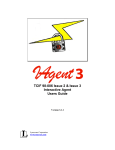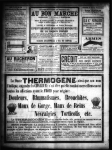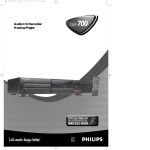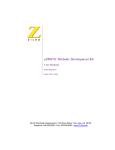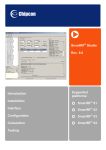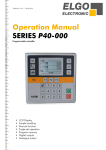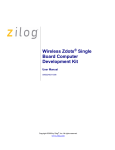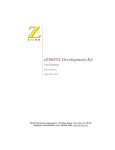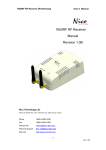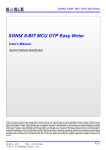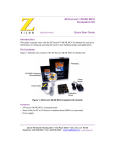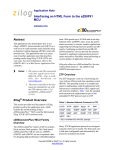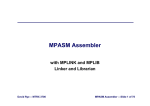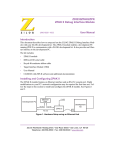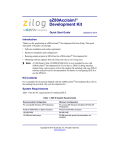Download PDF document - eetasia.com
Transcript
Application Note
A Webpage Interface for
the eZ80F91 MCU using
Java
AN017801-0304
ZiLOG Worldwide Headquarters • 532 Race Street • San Jose, CA 95126
Telephone: 408.558.8500 • Fax: 408.558.8300 • www.ZiLOG.com
Application Note
A Webpage Interface for the eZ80F91 MCU using Java
This publication is subject to replacement by a later edition. To determine whether a later edition
exists, or to request copies of publications, contact:
ZiLOG Worldwide Headquarters
532 Race Street
San Jose, CA 95126
Telephone: 408.558.8500
Fax: 408.558.8300
www.zilog.com
ZiLOG is a registered trademark of ZiLOG Inc. in the United States and in other countries. All other
products and/or service names mentioned herein may be trademarks of the companies with which
they are associated.
Information Integrity
The information contained within this document has been verified according to the general
principles of electrical and mechanical engineering. Any applicable source code illustrated in the
document was either written by an authorized ZiLOG employee or licensed consultant. Permission
to use these codes in any form, besides the intended application, must be approved through a
license agreement between both parties. ZiLOG will not be responsible for any code(s) used
beyond the intended application. Contact the local ZiLOG Sales Office to obtain necessary license
agreements.
Document Disclaimer
©2004 by ZiLOG, Inc. All rights reserved. Information in this publication concerning the devices,
applications, or technology described is intended to suggest possible uses and may be
superseded. ZiLOG, INC. DOES NOT ASSUME LIABILITY FOR OR PROVIDE A
REPRESENTATION OF ACCURACY OF THE INFORMATION, DEVICES, OR TECHNOLOGY
DESCRIBED IN THIS DOCUMENT. ZiLOG ALSO DOES NOT ASSUME LIABILITY FOR
INTELLECTUAL PROPERTY INFRINGEMENT RELATED IN ANY MANNER TO USE OF
INFORMATION, DEVICES, OR TECHNOLOGY DESCRIBED HEREIN OR OTHERWISE. Except
with the express written approval ZiLOG, use of information, devices, or technology as critical
components of life support systems is not authorized. No licenses or other rights are conveyed,
implicitly or otherwise, by this document under any intellectual property rights.
AN017801-0304
Application Note
A Webpage Interface for the eZ80F91 MCU using Java
iii
Table of Contents
List of Figures . . . . . . . . . . . . . . . . . . . . . . . . . . . . . . . . . . . . . . . . . . . . . . . . . iv
List of Tables . . . . . . . . . . . . . . . . . . . . . . . . . . . . . . . . . . . . . . . . . . . . . . . . . . iv
Abstract . . . . . . . . . . . . . . . . . . . . . . . . . . . . . . . . . . . . . . . . . . . . . . . . . . . . . . 1
ZTP Overview . . . . . . . . . . . . . . . . . . . . . . . . . . . . . . . . . . . . . . . . . . . . . . . . . 1
HTTP Server in ZTP . . . . . . . . . . . . . . . . . . . . . . . . . . . . . . . . . . . . . . . . . . 2
Java Applets and HTML . . . . . . . . . . . . . . . . . . . . . . . . . . . . . . . . . . . . . . . 3
Developing the Java-based Webpage Interface Application . . . . . . . . . . . . . . 3
Creating the Webpage . . . . . . . . . . . . . . . . . . . . . . . . . . . . . . . . . . . . . . . . . 6
Controlling the LEDs on the Development Board . . . . . . . . . . . . . . . . . . . 15
Controlling the LED Icons on the Webpage . . . . . . . . . . . . . . . . . . . . . . . 16
Adding and Integrating Application Specific Files to ZTP . . . . . . . . . . . . . 16
AN017801-0304
Demonstration . . . . . . . . . . . . . . . . . . . . . . . . . . . . . . . . . . . . . . . . . . . . . . . .
Requirements . . . . . . . . . . . . . . . . . . . . . . . . . . . . . . . . . . . . . . . . . . . . . .
Setup . . . . . . . . . . . . . . . . . . . . . . . . . . . . . . . . . . . . . . . . . . . . . . . . . . . . .
Settings . . . . . . . . . . . . . . . . . . . . . . . . . . . . . . . . . . . . . . . . . . . . . . . . . . .
Procedure . . . . . . . . . . . . . . . . . . . . . . . . . . . . . . . . . . . . . . . . . . . . . . . . .
22
22
22
23
23
Summary . . . . . . . . . . . . . . . . . . . . . . . . . . . . . . . . . . . . . . . . . . . . . . . . . . . .
Appendix A—Reference . . . . . . . . . . . . . . . . . . . . . . . . . . . . . . . . . . . . . . . .
Appendix B—Flowcharts . . . . . . . . . . . . . . . . . . . . . . . . . . . . . . . . . . . . . . . .
Appendix C—Source Code . . . . . . . . . . . . . . . . . . . . . . . . . . . . . . . . . . . . . .
C File . . . . . . . . . . . . . . . . . . . . . . . . . . . . . . . . . . . . . . . . . . . . . . . . . . . . .
Header File . . . . . . . . . . . . . . . . . . . . . . . . . . . . . . . . . . . . . . . . . . . . . . . .
HTML File . . . . . . . . . . . . . . . . . . . . . . . . . . . . . . . . . . . . . . . . . . . . . . . . .
Java Source Code File . . . . . . . . . . . . . . . . . . . . . . . . . . . . . . . . . . . . . . .
24
26
27
29
29
32
33
34
Table of Contents
Application Note
A Webpage Interface for the eZ80F91 MCU using Java
iv
List of Figures
Figure 1. General Setup with the eZ80F91 MCU as a Webserver . . . . . . . . . . 2
Figure 2. Communication between Client Browser and
the eZ80F91 Webserver . . . . . . . . . . . . . . . . . . . . . . . . . . . . . . . . . . 4
Figure 3. LED and Switch Control Demo Webpage . . . . . . . . . . . . . . . . . . . . . 5
Figure 4. Java Applet Component on HTML Webpage . . . . . . . . . . . . . . . . . . 5
Figure 5. Flowchart to Toggle the LEDs on Development Board
using Buttons . . . . . . . . . . . . . . . . . . . . . . . . . . . . . . . . . . . . . . . . . . 27
Figure 6. Flowchart to Change the Color of LED Icons on Webpage
using Switches . . . . . . . . . . . . . . . . . . . . . . . . . . . . . . . . . . . . . . . . . 28
List of Tables
Table 1.
AN017801-0304
List of References . . . . . . . . . . . . . . . . . . . . . . . . . . . . . . . . . . . . . . 26
List of Figures
Application Note
A Webpage Interface for the eZ80F91 MCU using Java
1
Abstract
An Internet-enabled product built around eZ80Acclaim!™ family of microcontrollers using the ZiLOG TCP/IP stack (ZTP) involves developing webpages to control
its functionality. This Application Note focuses on developing an application to
remotely control the pins of the eZ80F91 MCU from a webpage, and display the
status of a pin on the webpage. The details on how to write a Java applet, add the
applet into a HTML code, use ZTP’s HTTP-related APIs and integrate the complete system are discussed in this Application Note.
With this Java-based application, a two-way control mechanism is demonstrated
wherein the user controls the LEDs on the eZ80F91 Development Board via the
buttons on the webpage, and toggles the color of indicators (LED icons) on the
webpage using switches on the Development Board.
This Java-based Webpage Interface is thus another Java-enabled process control
application that uses the Internet/Intranet. (See related ZiLOG Application Note on
a Thermostat Demo using the eZ80F91 MCU.)
The source code file (saved in the WinZip format) associated with this Application
Note is AN0178-SC01.zip, and is available on the ZiLOG website.
ZTP Overview
Figure 1 depicts the general data communication path using the eZ80F91 Development Kit, the ZPAKII, and an Ethernet Hub. With this hardware, the eZ80F91
MCU is ready to be used as an efficient webserver when ZiLOG’s ZTP software is
downloaded on it. ZTP provides the software to drive the hardware used for TCP/
IP connections. This hardware comprises SERIAL1 (UART1/UART2) for PPP
connections and the Ethernet Media Access Controller (EMAC) for Ethernet connections among other peripherals.
The ZiLOG TCP/IP Software Suite (ZTP) contains a set of libraries that implement
an embedded TCP/IP stack and includes a pre-emptive, multi-tasking kernel.
The ZTP Applications Programming Interface (API) allows programmers using
any member of the eZ80® family of processors (including the eZ80Acclaim! product line) to rapidly develop internet-ready applications with minimal effort.
AN017801-0304
Abstract
Application Note
A Webpage Interface for the eZ80F91 MCU using Java
2
eZ80F91 Development Kit
(eZ80F910200ZC0)
RS-232
PC
J3
ZPAK -II
J4 ZDI
eZ80 ®
Development
Platform
P1
Ethernet
4 Port HUB
Ethernet
P2 Ethernet
Ethernet
LAN/WAN/INTERNET
Figure 1. General Setup with the eZ80F91 MCU as a Webserver
HTTP Server in ZTP
The implementation of Hyper TextTransfer Protocol (HTTP) in ZTP enables
eZ80F91 microcontroller to work as an HTTP server. The eZ80F91 MCU-based
products implemented as an HTTP server can store webpages and provide them
to browsers on demand. The HTTP layer also provides the facility of creating
socket connections between networked products and allows them to interchange
data reliably over the Ethernet.
For this Java-based Webpage Interface application, a C program supports the
webpages and helps the user interact with the webserver.
Using the ZTP HTTP user interface primarily involves writing user application
code that calls the appropriate ZTP HTTP API functions. It also involves integrating user webpages into the webserver using ZDSII.
ZTP HTTP CGI Functions
Embedded systems typically do not contain a file system. The lack of a file system
means that embedded systems cannot save CGI scripts as separate *.cgi files.
Instead of saving CGI scripts as separate *.cgi files, ZTP uses C function calls,
collectively called CGI functions. When a CGI function is called, the HTML code
stored in the webserver is sent to the web browser. It is in these function calls that
AN017801-0304
HTTP Server in ZTP
Application Note
A Webpage Interface for the eZ80F91 MCU using Java
3
a programmer writes code to read the information sent by a web browser. This
information is then processed as required by the application.
ZTP provides the following CGI functions to the user.
•
•
•
int http_output_reply(http_request *request, int reply)
char *http_find_argument(http_request *request, char *arg)
int _http_write(http_request *request, char *buff, int count)
In each ZTP CGI function, the pointer to the request structure is used to keep the
requests from different clients separate.
The function http_output_reply() is used to return an acknowledgement to
the browser that made the request.
The http_find_argument() function is used to extract parameters from the
received data in the parsed browser request.
The macro _http_write() is used to return data to the browser that sent the
request that invoked the CGI function.
For detailed information on the protocols used in ZTP, refer to the ZTP Programmer’s Guide (RM0008), available along with the ZTP software.
Java Applets and HTML
A Java applet is a program that adheres to a set of conventions that allow it to run
on Java-compatible browsers. Most of the standard HTML browsers support Java
applet execution. The standalone systems using Java applets must add a Java
Virtual Machine (JVM) to run an applet.
Hypertext Markup Language (HTML) is used to display information in webbrowsers. A webpage is basically coded in HTML, which is interpreted at run-time by the
browser. A webpage that can change its content depending on the information
obtained by the server at run-time, is called dynamic. A static page on the other
hand displays fixed information. Inserting an applet into the webpage allows the
webpage to display dynamic information because the applet changes its content
during run-time. The web browser creates the applet object when it encounters
the <applet> tag in the HTML code; the <applet> tag provides the name of the
Java class file (stored as Java byte code in the webserver) from which the applet
object is created. Visit www.java.sun.com for information on the Java language.
Developing the Java-based Webpage Interface Application
This section discusses the implementation of the Java-based Webpage Interface
in detail. The implementation of the operations that occur when a button is clicked
on the webpage and when a switch on the Development Board is pressed are
AN017801-0304
Java Applets and HTML
Application Note
A Webpage Interface for the eZ80F91 MCU using Java
4
explained in the following sections. The section also includes instructions on how
to interface the application specific files to the standard ZTP files.
The block diagram of eZ80F91 webserver setup for the Java-based Webpage
Interface application is shown in Figure 1. The eZ80F91 MCU is configured to
work as a webserver, and a client PC with a browser is used to control the GPIO
pins on the eZ80F91 MCU via the webpages. The switches SW1, SW2 and the
LEDs DCD (D1), RX (D2) are on the Development Board and are used to demonstrate the working of this application.
A browser is used to access the eZ80F91 webserver to obtain the current status
of different GPIO pins or to change the status of the pins and thereby control the
system over the Ethernet. The locally networked devices are connected together
in an intranet and are accessible to the outside world (Internet) through a gateway.
An overview of the communication between eZ80F91 webserver and an HTML
browser is illustrated in Figure 2.
HTTP request
eZ80F91 Webserver
(application hosting Java
applet in HTML file)
Client Browser
started on a PC
ZTP
Transmits
HTML
Client Browser
on a PC host
Client Browser
(running applet )
Client Browser
(running applet)
Establish socket
connection on
Port yyyy
Send Command/
Request data
eZ80F91 Webserver
(hosting Java applet in
HTML file)
eZ80F91 Webserver
(CGI function sends
HTTP_200_OK )
eZ80F91 Webserver
(CGI function controls
input /output to webpage)
Bi-directional communication
established
Figure 2. Communication between Client Browser and the eZ80F91 Webserver
The webserver transmits an HTML file (containing a link to the Java applet) to the
client browser. The Java applet contains a graphical user interface (GUI) component that is displayed on the webpage as shown in Figures 3 and 4. The webpage
displays the buttons that control the LEDs and the indicators (LED icons) that are
controlled by the switches on the Development Board.
AN017801-0304
Developing the Java-based Webpage Interface Application
Application Note
A Webpage Interface for the eZ80F91 MCU using Java
5
Figure 3. LED and Switch Control Demo Webpage
Figure 4 is a close-up of the Java applet display.
Figure 4. Java Applet Component on HTML Webpage
AN017801-0304
Developing the Java-based Webpage Interface Application
Application Note
A Webpage Interface for the eZ80F91 MCU using Java
6
Note: By default, the HTTP server closes the TCP connection as soon as the
HTTP request is processed and therefore persistent connections are not
possible.
The software implementation can be divided into the following sections:
•
•
Designing the webpage, which includes coding the Java applet for the GUI.
Developing the functionality, which comprises the following:
–
Implementing the functionality to control the LEDs on the Development
Board
–
Implementing the functionality to effect a change in the indicators (LED
icons) on the webpage using the switches on the Development Board
Creating the Webpage
The source code for the HTML file Switch.htm displays the webpage as shown in
Figure 3. The HTML script contains a link to the Java applet using the lines of
code as presented below:
<applet width="340" height="250" code="SwitchCtrl.class">
<param name="bgcolor" value="#FFFFFF">
</applet>
The applet is executed from the Java class file SwitchCtrl.class which is previously stored in the eZ80F91 webserver in the form of ASCII characters. The
SwitchCtrl.class file is obtained upon compiling the SwitchCtrl.java file.
The Java file SwitchCtrl.java is coded as detailed below. The entire Java
source code is available in Appendix C on page 29.
Importing Relevant Java Packages
In the SwitchCtrl.java file, the relevant packages that the main program uses
are imported in the beginning of the file. The packages are similar to the *.lib
and *.h files of the C language. In the program for the applet, the following packages containing the relevant classes are defined as imported:
import java.applet.Applet;
import java.awt.*;
import java.io.*;
import java.net.*;
import java.awt.event.*;
AN017801-0304
Creating the Webpage
Application Note
A Webpage Interface for the eZ80F91 MCU using Java
7
The imported packages are part of the core Java APIs that every Java program
uses in the Java run-time environment. The java.applet package contains
classes that are essential for Java applets. The java.awt package contains the
most frequently used classes in the Abstract Window Toolkit (AWT), which provides the Java graphical user interface (GUI) properties.
A sub-class to extend the properties provided to the applet by the packages is
implemented next, with the following lines of code:
public class SwitchCtrl extends Applet implements Runnable ,
ActionListener{
...
)
The extends keyword indicates that SwitchCtrl is a subclass of the Applet
class.
From the Applet class, applets inherit a great deal of functionality, the most important of which is the ability to respond to browser requests. When a Java-capable
browser loads a page containing an applet, the browser sends a request to the
applet telling the applet to initialize itself and start executing.
Declaring the Variables
After creating the Applet class, the variables that can be used by any function or
sub class are declared within the SwitchCtrl class as follows:
...
Socket rwSocket;
Socket inSocket;
Thread readThread;
String ipaddr=null;
String ip=null;
int portNumber;
int port;
Button xButton;
Button yButton;
DataOutputStream os;
DataInputStream is;
AN017801-0304
Creating the Webpage
Application Note
A Webpage Interface for the eZ80F91 MCU using Java
8
Image image1;
Color firstBulbColor = Color.green;
Color secondBulbColor = Color.green;
...
Initializing the Applet
The applet is initialized using the public void init() method. The init()
method is called when the applet is first created and loaded by the underlying software (the web browser). This method performs all the one-time operations that
the applet requires for its operation such as creating the user interface or setting
the font or displaying the logo.
...
public void init(){
...
}
The file formats *.gif and *.jpg are used to load and display images on the
browser screen. Images are stored as an instance of the Image class. The applet
method getImage() returns an instance of these files.
image1 = getImage(getDocumentBase(), "logo.gif");
Setting the Applet Background Colour
The following piece of code is used to set the background color of the applet
based on the color value received from the HTML page.
...
String s3 = getParameter("bgcolor");
if(s3 != null)
try{
setBackground(new Color(Integer.parseInt(s3.substring(1),
16)));
}
...
AN017801-0304
Creating the Webpage
Application Note
A Webpage Interface for the eZ80F91 MCU using Java
9
The catch() method that is used to handle errors and exceptions in Java is used
to handle invalid color values. The error message is displayed on the Java Console that can be opened from the web browser.
Note: The Java Console is available as an option under Tools in the web
browser when the Java Runtime Environment (JRE) is installed on the
client PC. The JRE can be downloaded from the website, http://
www.java.sun.com.
...
catch(NumberFormatException _ex){
System.out.println("Invalid format for bgcolor: " + s3);
}
setLayout(null);
...
Creating the Buttons
To create buttons with text, the method new Button() is used. The setBounds()
method specifies the area (the X and Y axis) where the button is to be placed on
the webpage and also specifies its width and height.
The add() method adds the new button to the Applet. The setEnabled() method
either activates or disables the button. The button is activated only when the setEnabled() method is true and disabled when it is false. The following code
illustrates the methods explained to create buttons.
...
xButton = new Button("D1");
xButton.setBounds(120, 160, 50, 30);
xButton.addActionListener(this);
add(xButton);
yButton = new Button("D2");
yButton.setBounds(180, 160, 50, 30);
yButton.addActionListener(this);
add(yButton);
xButton.setEnabled(true);
yButton.setEnabled(true);
AN017801-0304
Creating the Webpage
Application Note
A Webpage Interface for the eZ80F91 MCU using Java
10
...
Obtaining the Host IP Address
The applet is started using the public void start() method. The IP address of
the host where the applet is run must be obtained so that a socket can be opened
for a communication channel to be set up between the client and the webserver.
The following code is used to set the port number and obtain the host IP address,
which is then sent to the webserver (see the section on Adding and Integrating
Application Specific Files to ZTP on page 16).
...
public void start(){
System.out.println("Enter Start");
ipaddr = getCodeBase().getHost();
System.out.println("IP Addr
" + ipaddr.toString());
portNumber = 80;
System.out.println("PortNumber=" + portNumber);
The following code handles the error due to a connection failure.
try{
rwSocket = new Socket(ipaddr.toString(), portNumber);
}catch(UnknownHostException _ex){
System.out.println("An error occurred while establishing the
communication with the server");
}catch(IOException _ex){
System.out.println("Couldn't get I/O for the connection to: "
+ipaddr);
}catch(Exception e){
System.out.println("An error occurred while reading the
response.Try reloading the page. ");
}
A new thread is then created and started with the following lines of code:
if(readThread == null){
AN017801-0304
Creating the Webpage
Application Note
A Webpage Interface for the eZ80F91 MCU using Java
11
readThread = new Thread(this);
readThread.start();
}
Creating the Applet Heading
The text or the heading for the Applet is printed using the paint(Graphics)
method of the java.awt.Graphics package. The paint(Graphics) method is
coded as follows:
public void paint(Graphics g) {
System.out.println("Enter Graphics"+g);
g.setColor(Color.black);
g.fillRect(0,0,400,28);
g.drawImage(image1,0,0, this);
g.setColor(Color.white);
g.setFont(new Font("Arial", 1, 14));
g.drawString("LED and Switch Control Demo", 75, 18);
g.setColor(Color.yellow);
g.setFont(new Font("Arial", 1, 10));
g.drawString("Press the switches on the board to activate the
LEDs below", 40, 45);
g.setColor(Color.white);
g.setFont(new Font("Arial", 1, 10));
g.drawString("LED1", 139, 62);
g.drawString("LED2", 191, 62);
g.setColor(firstBulbColor);
g.fillOval(130,70,40,40);
g.setColor(secondBulbColor);
g.fillOval(185,70,40,40);
g.setColor(Color.yellow);
g.setFont(new Font("Arial", 1, 10));
g.drawString("To switch ON / OFF the LEDs on the board, click
the buttons", 25, 145);
System.out.println("Exit Graphics");
}
AN017801-0304
Creating the Webpage
Application Note
A Webpage Interface for the eZ80F91 MCU using Java
12
The setFont() method is used to set the font. The drawString() method prints
the specified text on the browser. The fillOval() method paints the LED icons
(labelled as LED1 and LED2 on the webpage) on the screen according to the
position (X and Y axis) and size (width and height) as specified. The setColor()
method is used to specify the color for the LED icon.
Synchronizing Independent Threads
To run the main thread and obtain the IP address of the client at Port 5000 (userspecified), the following code is used. The synchronized keyword tells the applet
to synchronize all the threads.
synchronized public void run() {
System.out.println("Enter RUN");
ip = getCodeBase().getHost();
System.out.println("IP Addr
" + ip.toString());
port = 5000;
Reading and Parsing the Data from the Port
When the applet runs, the browser displays the indicators (LED icons, LED1 and
LED2) and buttons (D1 and D2) on the screen.
The Socket class is used to set up Port 5000 for input. The data on the port is
then read and parsed to obtain the proper string value after eliminating & and \n
characters. This value is then passed to the method updateBulbStatus().
...
try{
inSocket = new Socket(ip.toString(),port);
is = new DataInputStream(inSocket.getInputStream());
System.out.println("InStream is:>> " +is);
while(true) {
str = "";
while((b = is.readByte()) != '&') { }
while ((b = is.readByte()) != '\n') {
str = str + (char)b; //read bytes, not Unicode characters
}
System.out.println("Input read is:>>" +str);
AN017801-0304
Creating the Webpage
Application Note
A Webpage Interface for the eZ80F91 MCU using Java
13
updateBulbStatus(str);
}
}catch(Exception e) {
System.out.println("An error occurred while reading the
response.Try reloading the page. ");
}
...
Changing the Color of the Indicators
The updateBulbStatus() method, which toggles the color of the indicators (LED
icons) on the webpage between red and green, is constructed as illustrated
below:
public void updateBulbStatus(String msg){
System.out.println("Enter UpdateBulbStatus");
System.out.println("Received String" +msg);
if (msg.equals("LED1on")) {
redraw(1,Color.red);
}
else if (msg.equals("LED1off")){
redraw(1,Color.green);
}
else if (msg.equals("LED2on")){
redraw(2,Color.red);
}
else if (msg.equals("LED2off")){
redraw(2,Color.green);
}
System.out.println("Exit updateBulbStatus");
}
...
AN017801-0304
Creating the Webpage
Application Note
A Webpage Interface for the eZ80F91 MCU using Java
14
Controlling the LEDs on the Development Board
When the button D1 or D2 is clicked on the webpage, the actionPerformed()
method is invoked and a data string corresponding to the clicked button is stored
in variable s.
...
public void actionPerformed(ActionEvent ev) {
System.out.println("Enter Action Performed");
String label = ev.getActionCommand();
String s = new String();
if(label.equals("D1")){
s = "command=1&dummy=0";
sendData(s);
}else if(label.equals("D2")){
s = "command=2&dummy=0";
sendData(s);
}
System.out.println("Exit Action Performed");
}
The data in the string s is sent to the socket by the sendData() method with an
alert for any error that may occur. After sending the data, the socket is closed to
complete the communication. The HTTP layer of the webserver listening on Port
5000 parses and interprets this data and provides the requisite value to the CGI
function switchinput_cgi.
...
public void sendData(String s) {
System.out.println("Enter SendData");
String s1 = null;
s1 =s;
s1 = "GET /switch_cgi?" + s1 + " HTTP/1.1\r\n\r\n";
System.out.println("Data to send =" + s1);
try{
System.out.println("rwSocket::"+rwSocket);
AN017801-0304
Creating the Webpage
Application Note
A Webpage Interface for the eZ80F91 MCU using Java
15
Socket outSocket = new Socket(ipaddr, portNumber);
os = new DataOutputStream(outSocket.getOutputStream());
os.flush();
os.write(s1.getBytes());
outSocket.close();
}catch(IOException _ex){
System.err.println("Write exception"+_ex);
}
System.out.println("Exit Send Data");
}
The Java source code construction for the applet is now complete. To compile this
code, the Java compiler version 1.1 must be installed on the PC (PCs with a web
browser such as Internet Explorer or Netscape already contain the Java VIrtual
Machine that contains the Java compiler). The following command, at the DOS
prompt, is used to compile the Java code:
Javac –deprecation –target 1.1 SwitchCtrl.java
After successful compilation, a class file SwitchCtrl.class is created. This class
file is further converted to a SwitchCtrl_class.c file (where the contents of the
file are stored in the form of an array) when the project is compiled using the
ZiLOG’s ZDSII compiler.
Controlling the LEDs on the Development Board
In the Java-based Webpage Interface application a CGI function,
switchinput_cgi() is used to call the ZTP HTTP CGI functions in order to read
the user input from the HTML webpage when the button D1 or D2 is clicked on the
webpage, and to transmit that input data to the Development Board. See the section ZTP HTTP CGI Functions on page 2.
The switchinput_cgi() function is declared as follows:
int switchinput_cgi(struct http_request *request)
This CGI function initially calls the ZTP HTTP API http_init() function to initialize the webserver, makes a TCP connection on the specified port and waits for a
client request. Upon receiving a request from the client, the webserver provides a
response according to the webserver configuration.
AN017801-0304
Controlling the LEDs on the Development Board
Application Note
A Webpage Interface for the eZ80F91 MCU using Java
16
The CGI function then calls the ZTP HTTP CGI function, http_output_reply()
to send an acknowledgement to the client browser. The http_find_argument()
is called to search for the string command indicating which of the buttons (D1 or
D2) is pressed; the respective LED on the Development Board is then switched
on/off. See the flowchart illustrating the sequence of events in Figure 5 on
page 27.
Controlling the LED Icons on the Webpage
The Port B of the eZ80F91 MCU is initialized with PB0 and PB1 as input pins and
PB3 and PB4 as output pins (see Switch.c file in the AN0178-SC01.zip file available on the ZiLOG website). Port B is continuously polled for any change in status
in ZTP’s main.c file.
When the SW1/SW2 switch on the Development Board is pressed, the change in
the switch status is captured by the Switch_Input() function (a flag is set or
reset to indicate the status of the switches) and an appropriate string is written for
the switch. The strings LEDon or LEDoff are used to indicate whether the LED
icons on the webpage must be displayed in green (OFF) or red (ON). These
strings are sent as arguments in the switchinput_cgi() function. See Controlling the LEDs on the Development Board section on page 15 for details of this
CGI function.
The ZTP HTTP API http_find_argument() is called within the
switchinput_cgi() function to search for the string (LED1on/LED1off). This
string is sent to the browser where the color of the indicators (LED icons, LED1/
LED2) on the webpage turns green or red. See the flowchart illustrating the
sequence of events in Figure 6 on page 28.
Adding and Integrating Application Specific Files to ZTP
The Java-based Webpage Interface application described in this Application Note
requires the eZ80® Development Board with the eZ80F91 MCU, and the ZiLOG
TCP/IP stack (ZTP). To execute this application, the files specific to the application must be added and integrated to the ZTP stack before the stack is downloaded onto the eZ80F91 MCU. This section contains the details of adding the
application specific files to the ZTP stack.
The Java-based Webpage Interface files are in the AN0178-SC01.zip file available on the ZiLOG website. The application files are of the following types:
•
•
•
•
AN017801-0304
C (*.c) files
Header (*.h) files
HTML (*.htm/*.html) files
Java (*.class) files
Controlling the LED Icons on the Webpage
Application Note
A Webpage Interface for the eZ80F91 MCU using Java
17
•
Image (*.gif) files
The ZTP stack is available on the ZiLOG website and can be downloaded to a PC
with a user registration key. ZTP can be installed in any location as specified by
the user; its default location is C:\Program Files\ZiLOG.
Note: Before adding and integrating the application specific files to ZTP, ensure
that all the settings for the ZTP stack are at default values.
Perform the following steps to add and integrate the Demo files to the ZTP stack:
1.
Download ZTP, browse to the location where ZTP is downloaded, and open
the \website.Acclaim folder.
2.
Download the AN0178-SC01.zip file and extract its contents to a folder on
your PC (this folder is referred to as \JavaWebControl folder in the rest of
the Application Note). Notice the two extracted folders within the
\JavaWebControl folder:
\JWC_Demo
\JWC_Website.Acclaim
3.
Select and copy the *.htm, *.class, *.h and the *.gif files in the
\JavaWebControl\JWC_Website.Acclaim folder and paste them into the
..\ZTP\website.Acclaim folder.
4.
Select and copy all the *.c, and *.h, files located in the
\JavaWebControl\JWC_Demo folder and paste them into the ..\ZTP\Demo
directory.
5.
Launch ZDSII and open the project file, website.pro located in the path:
..\ZTP\website.Acclaim.
6.
Now add the *.htm, *.class, *.h and the *.gif files located in the
..\website.Acclaim folder to the project, using the sequence of steps:
Project ® Add Files.
The *.htm, *.class, *.h and the *.gif files to be added are listed
below:
Switch.htm
SwitchCtrl.class
switch.h
logo.gif
AN017801-0304
Adding and Integrating Application Specific Files to ZTP
Application Note
A Webpage Interface for the eZ80F91 MCU using Java
18
7.
Open the website.c file from within ZDSII, and enter the following into it:
#include <Switch.h>
//HTML
extern struct staticpage switch_htm;
//CGI
int switchinput_cgi(struct http_request *request);
//Java applets
extern struct staticpage SwitchCtrl_class;
//for the image
extern const struct staticpage logo gif;
//for LED status
static unsigned char ledDCDstatus = 1;
static unsigned char ledRXstatus = 1;
8.
The website.c file contains the array, Webpage website[], with
information on the HTML pages. Replace the last line of the array, {0,
NULL, NULL, NULL }, with the following lines:
{HTTP_PAGE_STATIC, "/switch.htm","text/html", &switch_htm},
{HTTP_PAGE_DYNAMIC, "/switch_cgi", "text/html",(struct
staticpage *)switchinput_cgi},
{HTTP_PAGE_STATIC, "/logo.gif", "image/gif", &logo_gif},
{HTTP_PAGE_STATIC, "/SwitchCtrl.class", "application/octectstream", &SwitchCtrl_class},
{0, NULL, NULL, NULL};
9.
AN017801-0304
Add the following definition for the switchinput_cgi() function at the end
of the website.c file.
Adding and Integrating Application Specific Files to ZTP
Application Note
A Webpage Interface for the eZ80F91 MCU using Java
19
// Defintion for CGI Function
int switchinput_cgi(struct http_request *request)
{
char *switchstr;
int switchval;
http_output_reply(request,HTTP_200_OK);
// Get a pointer to string from Web page
switchstr = http_find_argument(request, (unsigned char*)
"command");
switchval = atoi(switchstr);// Get the Switch number
if (switchval == 1)
// If SW1 icon clicked
{
if (!ledDCDstatus)
// Check status of LED
{
PB_DR |= 0x08;
// PB3 set to High, DCD LED glows
ledDCDstatus = 1;
// Set Flag
}
else
{
PB_DR &= 0xF7;
// PB3 reset Low, DCD LED put off
ledDCDstatus = 0;
// Reset Flag
}
}
else if (switchval == 2)
{
if (!ledRXstatus)
{
PB_DR |= 0x10;
// PB4 set to High, RX LED glows
ledRXstatus = 1;
// Set Flag
}
else
{
AN017801-0304
Adding and Integrating Application Specific Files to ZTP
Application Note
A Webpage Interface for the eZ80F91 MCU using Java
20
PB_DR &= 0xEF;
// PB4 reset Low, RX LED put off
ledRXstatus = 0;
// Reset Flag
}
}
return( OK );
}
10.
From within ZDSII, open the left.htm file located in the \Web Files folder.
Search for CGI Calculator and locate the following line:
<a href="switch.htm" target="_top">CGI
Calculator</a><br>
11.
Add the following piece of HTML code below the CGI Calculator line, to
create a link from the default eZ80Acclaim! webpage to the Java-based
Webpage Interface Demo webpage.
<a href="switch.htm" target="main"> Java Web
Control </a><br>
12.
Build the website.pro project to obtain the new library file,
Acclaim_website.lib.
13.
Copy the Acclaim_website.lib library file to the path: ..\ZTP\libs.
Note: Please note that the ..ZTP\libs folder already contains an
Acclaim_website.lib file and it must be replaced with the newly
generated file. Click Yes to replace the file.
14.
15.
Close the website.pro project.
In ZDSII, open the AcclaimDemo.pro file available in the path:
..\ZTP\Demo.
16.
Add the *.c file located in the \JavaWebControl\JWC_Demo folder to the
project, using the sequence of steps: Project ® Add Files.
The *.c file to be added is Switch.c.
AN017801-0304
Adding and Integrating Application Specific Files to ZTP
Application Note
A Webpage Interface for the eZ80F91 MCU using Java
21
17.
Open the main.c file of the AcclaimDemo project and add the following
include file:
#include <switch.h>
18.
In the main.c file, observe the following BootInfo structure definition:
struct BootInfo Bootrecord = {
"192.168.1.1",/* Default IP address */
"192.168.1.4",/* Default Gateway */
"192.168.1.5",/* Default Timer Server */
"192.168.1.6",/* Default File Server */
"",
"192.168.1.7",/* Default Name Server */
"",
0xffffff00UL/* Default Subnet Mask */
};
The Bootrecord variable contains the network parameters and settings (in
the four-octet dotted decimal format) that are specific to the local area
network at ZiLOG, as default.
Modify the above structure definition with appropriate IP addresses
within your local area network.
19.
Add the following lines of code at the end of the main.c file, before the line
return OK; to call the Switch_Input() function at intervals of one second:
PortBInit();
//Initialize pin PB0 as Input
//Create a start task
resume(create((procptr)task1,1024,20,”task1”,0,0));
while(1)
//Loop forever
{
Switch_Input();
//Check status of SW1 and SW2
sleep(1);
}
AN017801-0304
Adding and Integrating Application Specific Files to ZTP
Application Note
A Webpage Interface for the eZ80F91 MCU using Java
22
20.
Open the eZ80_HW_Config.c file and change the default MAC address
(provided by ZTP) such that each eZ80 Development Board on the LAN
contains a unique MAC address. For example:
const BYTE f91_mac_addr [EP_ALEN] = {0x00, 0x90, 0x23, 0x00,
0xDF, 0x91};
In the 6 byte MAC address shown above, the first three bytes must not be
modified; the last three bytes can be used to assign a unique MAC address
to the eZ80 Development Board.
21.
Open the ipw_ez80.c file. For this application, DHCP (Dynamic Host
Configuration Protocol) is disabled; therefore, ensure the following:
b_use_dhcp = FALSE
22.
Save the files and close the AcclaimDemo project.
Demonstration
This section contains the requirements and instructions to set up the Java-based
Webpage Interface Demo and run it.
Requirements
The requirements are classified as hardware and software.
Hardware
•
•
eZ80F91 Development Kit (eZ80F910200ZCO)
PC with an Internet browser with the Java Virtual Machine
Software
•
•
ZiLOG Developer Studio II—IDE for eZ80Acclaim! (ZDSII)
ZiLOG’s TCP/IP stack (ZTP)
Setup
The basic setup to assemble the Java-based Webpage Interface demo is illustrated in Figure 1 on page 2. This setup illustrates the connections between the
PC, ZPAKII, LAN/WAN/Internet and the eZ80F91 Development Kit.
AN017801-0304
Demonstration
Application Note
A Webpage Interface for the eZ80F91 MCU using Java
23
Settings
HyperTerminal Settings
•
Set HyperTerminal to 57.6 Kbps Baud and 8-N-1, with no flow control
Jumper Settings
For the eZ80F91 Development Board
•
•
•
•
J11, J7, J2 are ON
J3, J20, J21, J22 are OFF
For J14, connect 2 and 3
For J19, MEM_CEN1 is ON, and CS_EX_IN, MEM_CEN2, and MEM_CEN3
are OFF
For the eZ80F91 Module on eZ80F91 Development Board
•
JP3 is ON
Additional Settings for the eZ80F91 Development Board
•
Connect PB3 of J6 Header to Pin6 of the J9 Connector. Count Pin6 starting
from the J9 marking.
•
Connect PB4 of J6 Header to Pin7 of the J9 connector. Count Pin7 starting
from the J9 marking.
Procedure
The procedure to build and run the Java-based Webpage Interface Demo is
described in this section.
AN017801-0304
1.
Ensure that the required Java-based Webpage Interface files are added and
integrated to ZTP before proceeding. See section Adding and Integrating
Application Specific Files to ZTP on page 16, for details.
2.
Make the connections as per Figure 1. Follow the jumper settings provided
in the section on Jumper Settings above.
3.
Connect the 9-volt power supply to the eZ80F91 Development Kit.
4.
Connect the 5-volt power supply to ZPAKII and the 7.5-volt power supply to
the Ethernet Hub.
5.
Launch the HyperTerminal and follow the settings provided in the
HyperTerminal Settings section above.
Settings
Application Note
A Webpage Interface for the eZ80F91 MCU using Java
24
6.
From within the HyperTerminal, press z repeatedly, and then press the reset
button on ZPAKII to view the menu to set the ZPAKII IP address.
7.
Enter H to display help menu, and follow the menu instructions to obtain the
IP address for ZPAKII in order to download the Demo file. This ZPAKII IP
address must be entered in the ZDSII.
8.
Launch ZDSII–for eZ80Acclaim! and open the Java-based Webpage
Interface project file (AcclaimDemo.pro) located in the path:
..\ZTP\Demo.
9.
Open the main.c file. Ensure that the BootInfo structure contains
information that is relevant to your network configuration. Use the IP
address in the structure to browse the Internet to view the Web Switch Demo
web pages.
10.
Build the project and download the resulting file to the eZ80F91 Module on
the eZ80 Development Board, using ZDSII.
11.
Run the Java-based Webpage Interface Demo. Refer to Running the Javabased Webpage Interface Demo section below.
Running the Java-based Webpage Interface Demo
1.
Launch the Internet browser on the PC. Enter the IP address for the
eZ80F91 Development Board specified in main.c. The Index.html page
is displayed. The LEDs (labeled DCD and RX) on the Development Board
light up to indicate an active link between the eZ80F91 webserver and the
PC-based client browser.
2.
Click on the link Java Web Control located in the left side of the screen. A
new web page (LED and Switch Control Demo) opens displaying the
buttons and the indicators (LED icons).
3.
Click on the button D1. Notice that the LED (labeled DCD) on the
Development Board is switched off and this on/off feature toggles on every
mouse click. The same procedure is performed on the D2 button for the LED
labeled Rx.
4.
Press the switch SW1/SW2 on the eZ80F91 Development Board. The color
of the indicator (LED icons) changes from red to green. Subsequent clicking
of the switches toggles the color of the LED icons on the webpage.
Summary
The eZ80F91 microcontroller is used for building Internet-enabled products that
are controlled over an Internet or Intranet using webpages. This Application Note
demonstrates how the current status of a pin on the eZ80F91 MCU can be
AN017801-0304
Summary
Application Note
A Webpage Interface for the eZ80F91 MCU using Java
25
remotely viewed and controlled by using a Java applet in a webpage. This type of
simple interface utilizes the HTTP component of ZiLOG’s ZTP stack and provides
reliable transfer and control of data. The details provided in this Application Note
can be used to build more complex user interfaces for real world applications.
AN017801-0304
Summary
Application Note
A Webpage Interface for the eZ80F91 MCU using Java
26
Appendix A—Reference
Further details about the eZ80F91 MCU, eZ80 CPU, and ZTP can be found in the
references listed in Table 1.
Table 1. List of References
Topic
Document Name
eZ80F91 MCU
eZ80F91 Development Kit User Manual (UM0142)
eZ80F91 Flash MCU with Ethernet MAC Product Specifications (PS0192)
eZ80F91 Module Product Specifications (PS0193)
eZ80 CPU
eZ80 CPU User Manual (UM0077)
ZiLOG’s TCP/IP
Software Suite (ZTP)
ZiLOG’s TCP/IP Software Suite Programmer’s Guide Reference Manual
(RM0008)
AN017801-0304
Appendix A—Reference
Application Note
A Webpage Interface for the eZ80F91 MCU using Java
27
Appendix B—Flowcharts
This appendix contains the flowcharts for the Java-based Webpage Control Interface implementation using the eZ80F91 MCU.
Figure 5 illustrates the flowchart for toggling the LEDs on the eZ80F91 Development Board using the D1 and D2 buttons on the webpage.
Start
Initialize webserver
using http_init
command
Establish HTTP
connection on Port 80
Request
received from
a client?
Received a
terminate
request?
Yes
End
No
No
Yes
Create a thread in ZTP OS
based on Client IP address
and Port number
Send HTTP_200_OK status
to client
Command
string = 1?
No
Yes
Toggle status of
LED D1
Figure 5. Flowchart to Toggle the LEDs on Development Board using Buttons
AN017801-0304
Appendix B—Flowcharts
Application Note
A Webpage Interface for the eZ80F91 MCU using Java
28
Figure 6 illustrates the flowchart for changing the color of the LED icons (LED1
and LED2) on the webpage using the SW1 and SW2 switches on the eZ80F91
Development Board.
Start
Initialize Port B pin
PB0 and PB1 as
Input
Is Switch SW1
pressed?
No
Yes
Is the Flag for
SW1 set?
Yes
No
Set the Flag for SW1
Send string 'LED1on' to
the client browser
Reset the Flag for SW1
Send string 'LED1off' to
the client browser
End
Figure 6. Flowchart to Change the Color of LED Icons on Webpage using Switches
AN017801-0304
Appendix B—Flowcharts
Application Note
A Webpage Interface for the eZ80F91 MCU using Java
29
Appendix C—Source Code
This appendix provides a listing of the source code associated with this Application Note. The source code file AN0178-SC01.zip is available on the ZiLOG website.
C File
Following C file is listed in this section:
•
Switch.c
/*
************************************************************
* File:
Switch.c
* Description: Function definition for Switch input.
*
* Copyright 2004 ZiLOG Inc. ALL RIGHTS RESERVED.
*
* The source code in this file was written by an
* authorized ZiLOG employee or a licensed consultant.
* The source code has been verified to the fullest
* extent possible.
*
* Permission to use this code is granted on a royalty-free
* basis. However users are cautioned to authenticate the
* code contained herein.
*
* ZiLOG DOES NOT GUARANTEE THE VERACITY OF THE SOFTWARE.
*************************************************************
*/
#include
#include
#include
#include
#include
<kernel.h>
<stdlib.h>
<tcb.h>
<dgram.h>
<switch.h>
// Include header file
volatile
volatile
unsigned
unsigned
char
char
char
char
//
//
//
//
read_switchSW1;
read_switchSW2;
switchon1;
switchon2;
void PortBInit(void)
{
PB_DR = 0x1B;
PB_DDR = 0x03;
AN017801-0304
Switch SW1 status
Switch SW2 status
Flag indicator for Switch SW1
Flag indicator for Switch SW2
// Initialize pin PB0
// PB0,PB1 = Input, PB3,PB4 = Output
Source Code
Application Note
A Webpage Interface for the eZ80F91 MCU using Java
30
PB_ALT1 = 0x00;
PB_ALT2 = 0x00;
}
int task2(int cfd)
{
while (1)
// Lookout for a new client
{
if (switchon1)
{
if (write(cfd,"&LED1on\n",9) == SYSERR)// Send status of SW1
// to Web page
break;
}
else
{
if (write(cfd,"&LED1off\n",10) == SYSERR)// Send default status
// (no change)
break;
}
if (switchon2)
{
if (write(cfd,"&LED2on\n",9) == SYSERR)// Send status of SW2
// to Web page
break;
}
else
{
if (write(cfd,"&LED2off\n",10) == SYSERR)// Send default status
// (no change)
break;
}
sleep(2);
}
}
close(cfd);
// task2
// Close port on client disconnect or error
int task1(void)
{
int dev, cfd;
int port = 5000;
if((dev = open(TCP, ANYFPORT,(char *) port)) == SYSERR) // Open an
// available port
return(SYSERR);
// Report error on problem
control(dev,TCPC_LISTENQ,(char*)5,0);
AN017801-0304
// Open port in Listen mode
C File
Application Note
A Webpage Interface for the eZ80F91 MCU using Java
31
while(1)
{
cfd = control(dev,TCPC_ACCEPT,0,0);
if(cfd == SYSERR)
return SYSERR;
// Wait for a client
// connection
// Report error on problem
resume(create((procptr)task2,1024,20,"task2",1,cfd));
// Create & start a new task
}
}
// task1
int Switch_Input(void)
{
int dev, cfd;
int port = 5000;
read_switchSW1 = PB_DR & SW1;
read_switchSW2 = PB_DR & SW2;
if(!read_switchSW1)
{
if (!switchon1)
switchon1 = 1;
else
switchon1 = 0;
}
}
if(!read_switchSW2)
{
if (!switchon2)
switchon2 = 1;
else
switchon2 = 0;
}
return OK;
// Switch_Input
// Get status of SW1
// Get status of SW2
// If switch SW1 is pressed
// and earlier it was off
// Then put on flag
// Otherwise reset flag
// If switch SW2 is pressed
// and it was off
// Then put on flag
// Otherwise reset flag
/*****************************************************************
**************************End of file*****************************
******************************************************************/
AN017801-0304
C File
Application Note
A Webpage Interface for the eZ80F91 MCU using Java
32
Header File
This section contains the following header file:
•
switch.h
/*
************************************************************
* File:
switch.h
* Description: Function declarations for Switch input.
*
* Copyright 2004 ZiLOG Inc. ALL RIGHTS RESERVED.
*
* The source code in this file was written by an
* authorized ZiLOG employee or a licensed consultant.
* The source code has been verified to the fullest
* extent possible.
*
* Permission to use this code is granted on a royalty-free
* basis. However users are cautioned to authenticate the
* code contained herein.
*
* ZiLOG DOES NOT GUARANTEE THE VERACITY OF THE SOFTWARE.
*************************************************************
*/
#ifndef _SWITCH_H_
#define _SWITCH_H_
#include <_eZ80F91.h>
#define SW10x01
#define SW20x02
// PB0 switch1 input for LEDicon1
// PB1 switch2 input for LEDicon2
void PortBInit(void);
int Switch_Input(void);
// Initialize pin PB0
// Check SW1
int task2(int cfd);
int task1(void);
// Prototype function
// declarations
#endif
/*****************************************************************
**************************End of file*****************************
******************************************************************/
AN017801-0304
Header File
Application Note
A Webpage Interface for the eZ80F91 MCU using Java
33
HTML File
The following HTML file is listed in this section:
•
Switch.htm
<html>
<!
* File:
Switch.htm
* Description: HTML file for the Java Web Control webpage.
*
* Copyright 2004 ZiLOG Inc. ALL RIGHTS RESERVED.
*
* The source code in this file was written by an
* authorized ZiLOG employee or a licensed consultant.
* The source code has been verified to the fullest
* extent possible.
*
* Permission to use this code is granted on a royalty-free
* basis. However users are cautioned to authenticate the
* code contained herein.
*
* ZiLOG DOES NOT GUARANTEE THE VERACITY OF THE SOFTWARE.
-->
<head>
<meta http-equiv="Content-Type" content="text/html; charset=iso-8859-1">
<title></title>
</head>
<body>
<p align="center">
<applet CODE="SwitchCtrlNew.class" WIDTH="350" HEIGHT="200">
<param name="bgcolor" value="#5563A4">
</applet>
</p>
</body>
</html>
AN017801-0304
HTML File
Application Note
A Webpage Interface for the eZ80F91 MCU using Java
34
Java Source Code File
This section contains the Java source code file for the applet. The following file is
listed in this section:
•
//
//
//
//
//
//
//
//
//
//
//
//
//
//
//
SwitchCtrl.java
File:
SwitchCtrl.java
Description: Source code file for the applet.
Copyright 2004 ZiLOG Inc.
ALL RIGHTS RESERVED.
The source code in this file was written by an
authorized ZiLOG employee or a licensed consultant.
The source code has been verified to the fullest
extent possible.
Permission to use this code is granted on a royalty-free
basis. However users are cautioned to authenticate the
code contained herein.
ZiLOG DOES NOT GUARANTEE THE VERACITY OF THE SOFTWARE.
//Import the various classes required to run the applet
import
import
import
import
import
java.applet.Applet;
java.awt.*;
java.io.*;
java.net.*;
java.awt.event.*;
public class SwitchCtrlNew extends Applet implements Runnable ,
ActionListener{
//Declare the variables
Socket rwSocket;
Socket inSocket;
Thread readThread;
String ipaddr=null;
String ip=null;
int portNumber;
int port;
Button xButton;
Button yButton;
DataOutputStream os;
DataInputStream is;
AN017801-0304
Java Source Code File
Application Note
A Webpage Interface for the eZ80F91 MCU using Java
35
Image image1;
String numbStr;
Thread readThread1;
Color firstBulbColor = Color.green;
Color secondBulbColor = Color.green;
// Initialize the variables
public void init(){
System.out.println("Enter init");
image1 = getImage(getDocumentBase(), "logo.gif");
setLayout(null);
String s3 = getParameter("bgcolor");
if(s3 != null)
try {
setBackground(new Color(Integer.parseInt(s3.substring(1),16)));
}
catch(NumberFormatException _ex) {
System.out.println("Invalid format for bgcolor:" + s3);
}
setLayout(null);
xButton = new Button("D1");
xButton.setBounds(120,160,50,30);
xButton.addActionListener(this);
add(xButton);
yButton = new Button("D2");
yButton.setBounds(180,160,50,30);
yButton.addActionListener(this);
add(yButton);
xButton.setEnabled(true);
yButton.setEnabled(true);
System.out.println("Exit init");
}
// Start the Applet
public void start(){
System.out.println("Enter Start");
ipaddr = getCodeBase().getHost();
System.out.println("IP Addr" + ipaddr.toString());
portNumber = 80;
System.out.println("PortNumber="+portNumber);
int SWBuffSize = 250;
try{
rwSocket = new Socket(ipaddr.toString(),portNumber);
}catch(UnknownHostException _ex){
AN017801-0304
Java Source Code File
Application Note
A Webpage Interface for the eZ80F91 MCU using Java
36
System.out.println("An error occurred while establishing the
communication with the server");
}catch(IOException _ex){
System.out.println("Couldn't get I/O for the connection to:"+ipaddr);
}catch(Exception e){
System.out.println("An error occurred whilereading the response.Try
reloading the page.");
}
if(readThread == null){
readThread = new Thread(this);
readThread.start();
}
System.out.println("Exit Start");
}
//Write the text and draw the LED image
public void paint(Graphics g) {
System.out.println("Enter Graphics"+g);
g.setColor(Color.black);
g.fillRect(0,0,400,28);
g.drawImage(image1,0,0, this);
g.setColor(Color.white);
g.setFont(new Font("Arial",1,14));
g.drawString("LED and Switch Control Demo",75,18);
g.setColor(Color.yellow);
g.setFont(new Font("Arial",1,10));
g.drawString("Press the switches on the board to activate the LEDs",
40,45);
g.setColor(Color.white);
g.setFont(new Font("Arial",1,10));
g.drawString("LED1",139,62);
g.drawString("LED2",191,62);
g.setColor(firstBulbColor);
g.fillOval(130,70,40,40);
g.setColor(secondBulbColor);
g.fillOval(185,70,40,40);
g.setColor(Color.yellow);
g.setFont(new Font("Arial",1,10));
g.drawString("To switch ON / OFF the LEDs on the board, click the
buttons",25,145);
System.out.println("Exit Graphics");
}
public void redraw(int bulbNo,Color bulbColor) {
if(bulbNo == 1){
this.firstBulbColor = bulbColor;
}else if(bulbNo == 2){
AN017801-0304
Java Source Code File
Application Note
A Webpage Interface for the eZ80F91 MCU using Java
37
this.secondBulbColor = bulbColor;
}
repaint();
}
// Stop the thread
public void stop() {
System.out.println("Enter Stop");
System.out.println("Exit Stop");
}
//Destroy the thread
public void destroy() {
System.out.println("Enter Destroy");
System.out.println("Exit Destroy");
}
//synchronize the threads
synchronized public void run() {
System.out.println("Enter RUN");
ip = getCodeBase().getHost();
System.out.println("IP Addr"+ip.toString());
port = 5000;
System.out.println("PortNumber="+port);
String str = "";
String rd;
byte b;
try{
inSocket = new Socket(ip.toString(),port);
is = new DataInputStream(inSocket.getInputStream());
System.out.println("InStream is:>>" +is);
while(true) {
str = "";
while((b = is.readByte()) != '&') { }
while ((b = is.readByte()) != '\n') {
str = str + (char)b; // read bytes, not Unicode characters
}
System.out.println("Input read is:>>" +str);
updateBulbStatus(str);
}
}catch(Exception e) {
System.out.println("An error occurred while reading the response.Try
reloading the page.");
}
AN017801-0304
Java Source Code File
Application Note
A Webpage Interface for the eZ80F91 MCU using Java
38
}
public void updateBulbStatus(String msg){
System.out.println("Enter UpdateBulbStatus");
System.out.println("Received String" +msg);
// BulbCanvas canvas = this.canvas;
if (msg.equals("LED1on")) {
redraw(1,Color.red);
}
else if (msg.equals("LED1off")){
redraw(1,Color.green);
}
else if (msg.equals("LED2on")){
redraw(2,Color.red);
}
else if (msg.equals("LED2off")){
redraw(2,Color.green);
}
System.out.println("Exit updateBulbStatus");
}
//When the button is clicked, send
//the LED on the board
relevant information to control
public void actionPerformed(ActionEvent ev) {
System.out.println("Enter Action Performed");
String label = ev.getActionCommand();
String s = new String();
if(label.equals("D1")){
s = "command=1&dummy=0";
sendData(s);
}else if(label.equals("D2")){
s = "command=2&dummy=0";
sendData(s);
}
System.out.println("Exit Action Performed");
}
//Send the data to the control program on the HTTP server
public void sendData(String s) {
System.out.println("Enter SendData");
String s1 = null;
s1 =s;
s1 = "GET /switch_cgi?" + s1 + " HTTP/1.1\r\n\r\n";
System.out.println("Data to send =" + s1);
try{
AN017801-0304
Java Source Code File
Application Note
A Webpage Interface for the eZ80F91 MCU using Java
39
System.out.println("rwSocket::"+rwSocket);
//
System.out.println("Received from Server:" +numbStr);
Socket outSocket = new Socket(ipaddr, portNumber);
os = new DataOutputStream(outSocket.getOutputStream());
os.flush();
os.write(s1.getBytes());
outSocket.close();
}catch(IOException _ex){
System.err.println("Write exception"+_ex);
}
System.out.println("Exit Send Data");
}
}
//End of file//
AN017801-0304
Java Source Code File











































